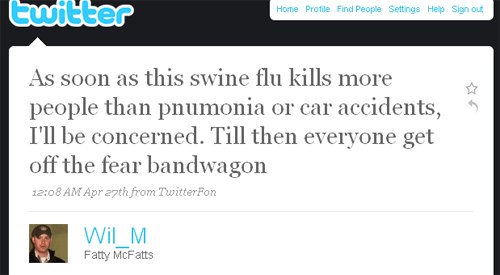You must have heard news of the swine flu. Over the past few days, its been on the top of Twitter’s trending topics. Everybody is talking about it.
I checked out what people were saying. While most of them were updates, prayers, and positive notes, there were also some interesting stuff. One is an interesting discussion on Twitter causing the fear to spread faster than the flu itself.
I noted a few tweets which were telling people something like “Don’t worry about swine flu, because there are more car accidents a day than swine flu cases!”
Here’s one.
Its true. Everyday, hundreds (or even thousands) of people die in car accidents all around the world. From a strict numbers standpoint, the broadcasters should tell people to fasten their car seatbelts, instead of avoiding crowded places and wearing masks.
But why is there such a global concern about the flu? Why aren’t the news covering the hundreds of deaths caused by car accidents?
The answer? It all boils down to one thing. Because the flu is viral. In simple words, it is because an infected person has the ability to pass on the flu to someone else. Today, 100 people can be infected. Tomorrow, there is a possiblity that each one of these 100 pass it on to another 100, each. That makes it 10000. In fact, its just been a couple of days, and we are now already seeing an increasing number of cases in other parts of the world.
That is why there is concern for a pandemic.
Car accidents are not viral. Going close to someone who doesn’t wear his seatbelt doesn’t force you from not wearing yours. It doesn’t spread this way.
Now I’m not saying that we should now all hide in our homes and breathe from oxygen tanks. I’ll leave that to the governments and the medical advisories to announce (and I hope the situation never get to that stage). What I want to bring across is how you can relate this to marketing.
This is why they call this Viral marketing.
Is your marketing viral? Are you making it easy for word of your product to spread? Are you facilitating the ease for one customer to tell his friends about his experience using your products?
Or are you still trying the “car accidents” way, launching campaign after campaign, spending tonnes of money in advertising and press releases, trying hard to “unbuckle every seatbelt you see”? How long can you last with this before you bang your head on the wall and give up?
You choose.
I’d spend my time planning and implementing a viral mechanism, rather than follow the crowd like a headless chicken, throwing money away on ads.
Viral Ideas
So how do you get your marketing to go viral? Internet Marketing guru Seth Godin also has this post about what makes an idea viral.
Here are some ideas you can start to implement that will take your marketing viral.
- Offer a bonus to your customer for recommending 5 of his friends to your product. (a.k.a. “Tell a Friend”)
- Create a video that is completely out of this world (hilariously funny, makes people cry, or pisses off every other human being), and post it on YouTube.
- Do an absolutely fabulous job for your first five clients, and make sure these clients are Otaku (from Seth). Let them spread the your word for you.
- Make it easy for people to spread the word. If you are using WordPress use ShareThis, at the bare minimum. If not, create a template like Nettuts.
- Move the free line. Give out a massive amount of valuable information for free!
Any other viral ideas?



 On my way back from my dinner yesterday, I saw a cat trying to prey on a rat. I stopped walking to observe what will happen, expecting an exciting chase and ferocious battle, hoping to get some real life urban “
On my way back from my dinner yesterday, I saw a cat trying to prey on a rat. I stopped walking to observe what will happen, expecting an exciting chase and ferocious battle, hoping to get some real life urban “ It is no secret that if you create a long list of resources – like “
It is no secret that if you create a long list of resources – like “